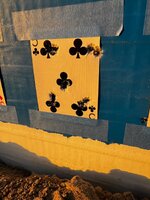RockAndSage
WKR
@RockAndSage I would love to hear more about this, if your wouldn’t. I’ve been looking for resources on this type of testing/practice.
You remember the phase, "Keep your eye on the ball"?
It's very much the same thing.
When I first had this explicitly taught to me with guns, my instructor shared that it had been his mentor/instructor that brought the baseball analogy into their sphere of shooting, having read or seen an interview with a baseball great named Ted Williams - who was an exceptional hitter. Williams, apparently, was able to focus so intently on a ball pitched to him that he could see the stitching, figure out which way the ball was spinning, and track it right to his swinging bat. Never let his eye off the ball. Part of that was actually the quality of his eyesight (20/10), but it was the focus that was emphasized.
This was all taught to me back before pistol optics, so some of the stuff is both dated and iron-sight specific, but we'd do drills morning, mid-day, and evening before bed that were entirely focused on rapid focus shift. Thumb-tacks on walls work great in the beginning for horizontal, single-plane focus training, but that gets pared down to tiny nails/pins after a bit, to teach focus on an even smaller pinpoint. One to the other, as fast and as physically/mentally focused as possible - look, lock, focus, shift fast, repeat.
Then mix in different distances, going back and forth from target to pencil tip in your weak-hand at arm's length (simulating front-sight), then the target then pencil, back and forth, shifting targets with your eyes first and the pencil-tip following. Never the other way around. The pencil tip was used to emphasize extremely fine focus, teaching your eyes and your mind how to focus, physically and neurologically, as precisely as possible.
Then mix in your actual gun: Target, front-sight, shift eye focus to next target, front-sight following, focus on target finely, shift to front sight.
(Note: the more precise you need the shot to be, the more precisely you have to see the tiny point you're aiming at and then shift to your front sight. The faster and less-precise you need to be, the more you can get away with a flash sight-picture or just staying focused on your target and looking at the sights more as peripheral reference. The guttersnipe sight system of the 1980s is an example of a target-focused sighting concept that emphasized speed over precision out to about 10ish yards, which is roughly max for most people's ability with a flash sight-picture with normal irons. There were even early versions a kind of target-focused occluded aiming red-dot system on some of the ARs that our guys took on the Son Tay raid, all the way back in Vietnam. Let the situation and the tools dictate your aiming solution, be flexible, experiment and learn your limitations).
Do the focus exercises when riding in a vehicle too (not driving). Spot something coming toward you, and viciously focus on it as finely as possible, without moving your head (eye training, not head training). Also, if you can find a safe place with a lot of birds or bugs flying around, it's absolutely excellent training for focus and the hand-eye coordination of keeping your gun on a moving, unpredictable target.
Another level is to walk around, keeping your eyes focused on your target as you walk around a room. Then add in your pencil or pistol sight, going back and forth from target to sight (with irons, for precision) as you move and navigate around a room's obstacles. It'll also teach your sensory systems to navigate obstacles without directly looking at them. Do that faster and faster until you're running. If it's not a precision shot (ie, a hostage-rescue shot needing the bullet placed past an innocent's face and into a $hithead's cerebellum), or if you're using a red-dot, stay focused on that target spot.
You're not aiming "center mass" or "head" - you're aiming for the 3rd button on his shirt, or the pimple on the tip of his nose. It's that focused and that visceral. Learning how to choose a tiny spot on a "big" target is part of this - going from big-picture to seeing a tiny little aiming reference in a flash, and drilling rounds through it.
It's worth pointing out that red-dots are an absolute leap in capability, for someone who's willing to put the time in - it reduces mental and sensory load in making the shot, and allows the massive advantage of staying focused on a very precise spot on the target.
To give you an idea of just how much target focus matters, take a look at this target - it's 5 yards, 10 rounds, two shots on each spot, done in 18 seconds, with a red-dot on a pistol. See how virtually every shot is touching its mate? But notice how the pattern isn't consistent between each spot? One spot is 2 both low, another is 2 both high, but centered? Then 2 touching, but to the right?
This is what happens when you focus on the spot for the first shot, but then focus on the bullet hole of the first to break the second shot. It's actually an example of focus fail.

